ATI's New High End and Mid Range: Radeon X1950 XTX & X1900 XT 256MB
by Derek Wilson on August 23, 2006 9:52 AM EST- Posted in
- GPUs
A Matter of Memory: Revisiting the Mid-Range
When 512MB cards first came along (with the GeForce 7800 GTX 512), we ran some performance tests to try and ascertain the real world performance difference between these cards and ones with 256MB of RAM. We came up empty handed at the time. Today we are able to show that memory sizes above 256MB are actually starting to matter. With ATI's launch of the new X1900 XT 256MB, we have a direct comparison between two cards which are almost identical aside from the amount of memory on board. To be completely fair, X1900 XT 256MB cards built by ATI will also have full HDCP support, keys and all, but the major difference remains RAM.
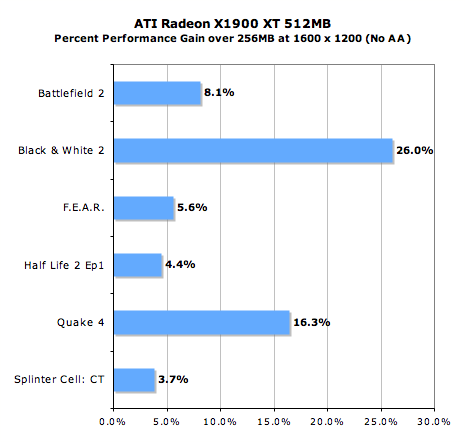
ATI dropped down to eight 8Mx32 as opposed to the eight 16Mx32 GDDR3 modules used on the original X1900 XT. Memory speed, bandwidth, and even layout can remain the same between cards, with only a slight difference in timings due to the different capabilities of each chip type. The result is that the X1900 XT 256MB is a slower solution than the X1900 XT that still offers exceptional performance for a terrific price.
The graphs below compare the new $279 X1900 XT 256MB to the rest of the sub-$300 cards we included in last week's mid-range GPU roundup. Note that the X1900 XT's chief competitor is NVIDIA's GeForce 7900 GT, which itself can be found for around $270. However, for as little as $20 more you can get a factory overclocked 7900 GT such as the eVGA GeForce 7900 GT KO SC clocked at 580/790 that all of the sudden becomes far more competitive. Because of the prevelance of factory overclocked (and warrantied) 7900 GTs, we've included the eVGA card as a reference of what you can get for the same price.
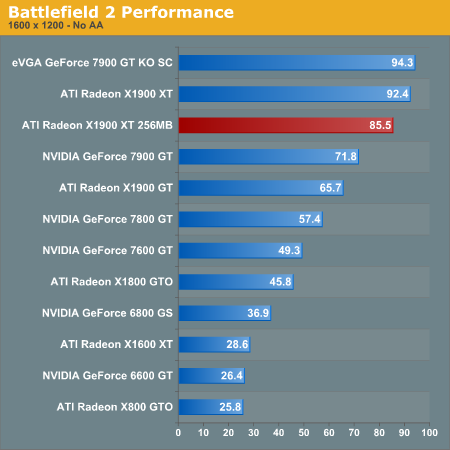
The 256MB drop in memory size doesn't impact BF2 enough to drop performance below the 7900 GT. The overclocked EVGA card does out perform even the 512MB X1900 XT in this test, but the 256MB version doesn't loose much value here as 85 fps is still way more than playable.
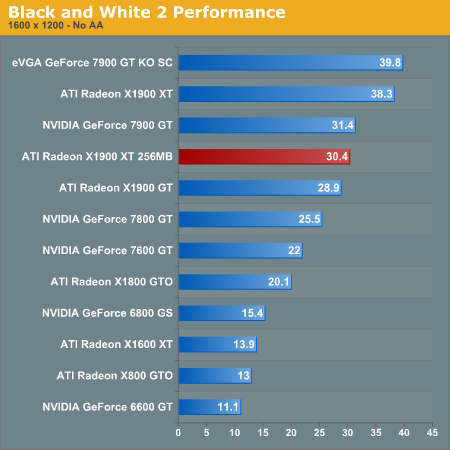
The 256MB X1900 XT falls in performance to just below the level of the stock 7900 GT. The competition is still tight, and we are about on par for the money here.
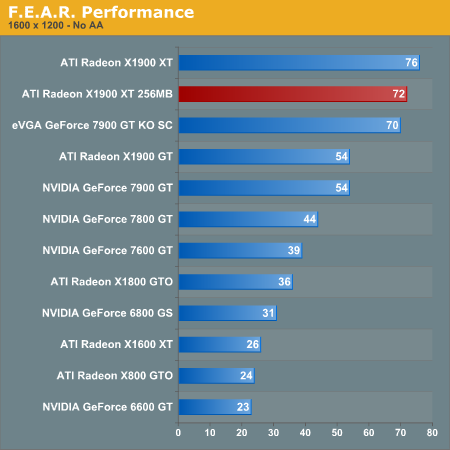
If F.E.A.R. performance is important to you, the X1900 XT 256MB is a better value than even the overclocked 7900 GT. The 512MB card still retains a small 5.5% lead over the 256MB card. This is one of the smaller performance drops we will see.
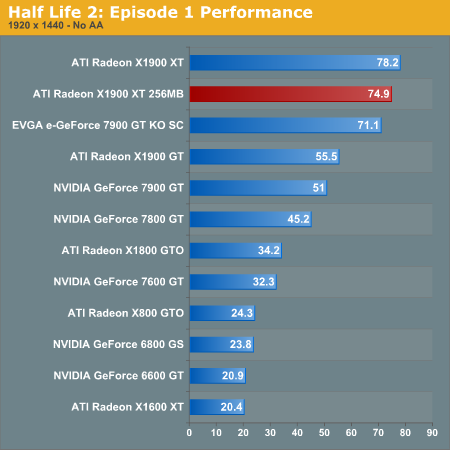
Under HL2:Ep1, performance drops a very small amount, but both X1900 XT cards are in strong competition with the overclocked 7900 GT.
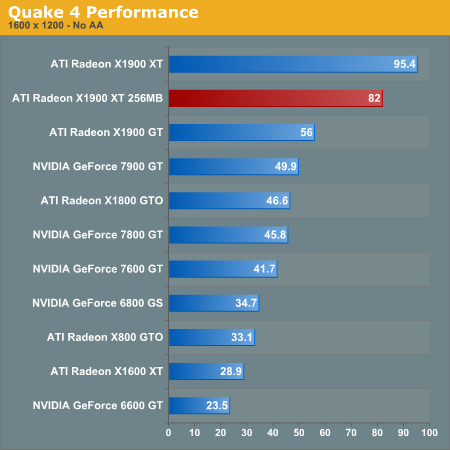
Quake 4 does give the 512MB card a bit of an advantage at 1600 x 1200, but the performance of the 256MB X1900 XT is still quite respectable given its target price of $279. The stock GeForce 7900 GT isn't in the same league as the X1900 XT.
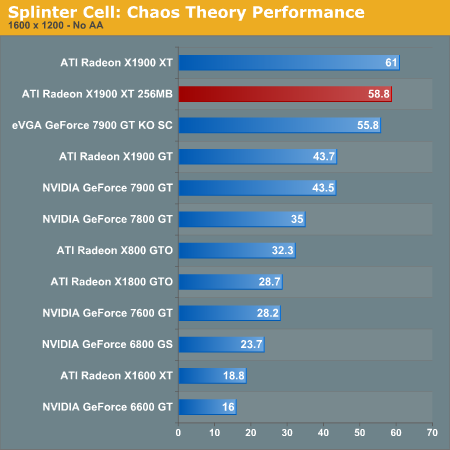
Spinter Cell rounds out our tests as one of those games where the larger frame buffer on the older X1900 XT does not do much. You lose less than 4% of your performance when going to the cheaper 256MB X1900 XT, which is a trade off we can live with. The regular GeForce 7900 GT can't hope to keep up with the 256MB X1900 XT, but if you get one of the factory overclocked cards such like the eVGA GeForce 7900 GT KO SC (more acronyms please) then you'll actually have performance competitive to the X1900 XT 256MB.
If the X1900 XT 256MB actually debuts at the ATI suggested price of $280, there won't be much of a reason to recommend anything but ATI parts from $220 up until we reach the highest end parts at above $400 where the lines start to blur again. While performance can fall very short of the X1900 XT 512MB at times, the X1900 XT 256MB remains competitive with our overclocked 7900 GT in every case but Black & White 2. The reduced memory version of the X1900 XT is just what ATI needed to pull out in order to fight back against the incredible overclockability of the 7900 GT.










74 Comments
View All Comments
SixtyFo - Friday, September 15, 2006 - link
So do they still use a dongle between the cards? If you had 2 xfire cards then it won't be connecting to a dvi port. Is there an adaptor? I guess what I'm asking is are you REALLY sure I can run 2 crossfire ed. x1950s together? I'm about to drop a grand on video cards so that piece of info may come in handy.unclebud - Friday, September 1, 2006 - link
"And 10Mhz beyond the X1600 XT is barely enough to warrant a different pair of letters following the model number, let alone a whole new series starting with the X1650 Pro."nvidia has been doing it for years with the 4mx/5200/6200/7300/whatever and nobody here said boo!
hm.
SonicIce - Thursday, August 24, 2006 - link
How can a whole X1900XTX system use only 267 watts? So a 300w power supply could handle the system?DerekWilson - Saturday, August 26, 2006 - link
generally you need something bigger than a 300w psu, because the main problem is current supply on both 12v rails must be fairly high.Trisped - Thursday, August 24, 2006 - link
The crossfire card is not the same as the normal one. The normal card also has the extra video out options. So there is a reason to buy the one to team up with the other, but only if you need to output to a composite, s-video, or component.JarredWalton - Thursday, August 24, 2006 - link
See discussion above under the topic "well..."bob4432 - Thursday, August 24, 2006 - link
why is the x1800xt left out of just about every comparison i have read? for the price you really can't beat it....araczynski - Thursday, August 24, 2006 - link
...I haven't read the article, but i did want to just make a comment...having just scored a brand new 7900gtx for $330 shipped, it feels good to be able to see the headlines for articles like this, ignore them, and think "...whew, i won't have to read anymore of these until the second generation of DX10's comes out..."
I'm guessing nvidia will be skipping the 8000's, and 9000's, and go straight for the 10,000's, to signal the DX10 and 'uber' (in hype) improvements.
either way, its nice to get out of the rat race for a few years.
MrJim - Thursday, August 24, 2006 - link
Why no Anisotropic filtering tests? Or am i blind?DerekWilson - Saturday, August 26, 2006 - link
yes, all tests are performed with at least 8xAF. Under games that don't allow selection of a specific degree of AF, we choose the highest quality texture filtering option (as in BF2 for instance).AF comes at fairly little cost these days, and it just doesn't make sense not to turn on at least 8x. I wouldn't personally want to go any higher without angle independant AF (like the high quality af offered on ATI x1k cards).